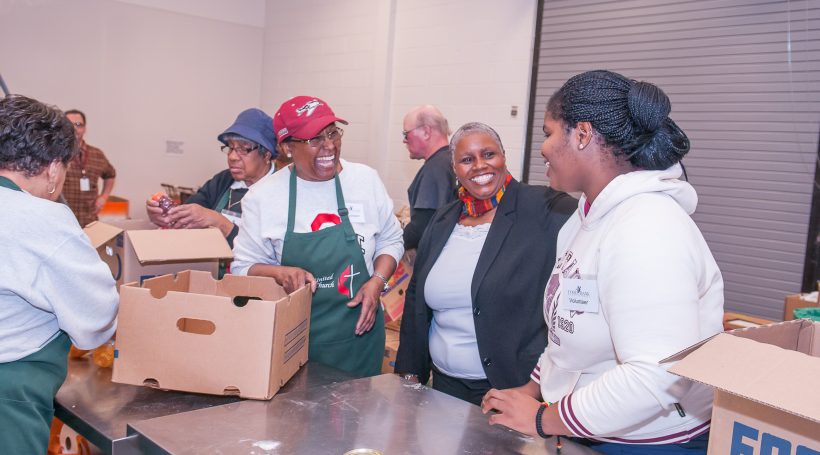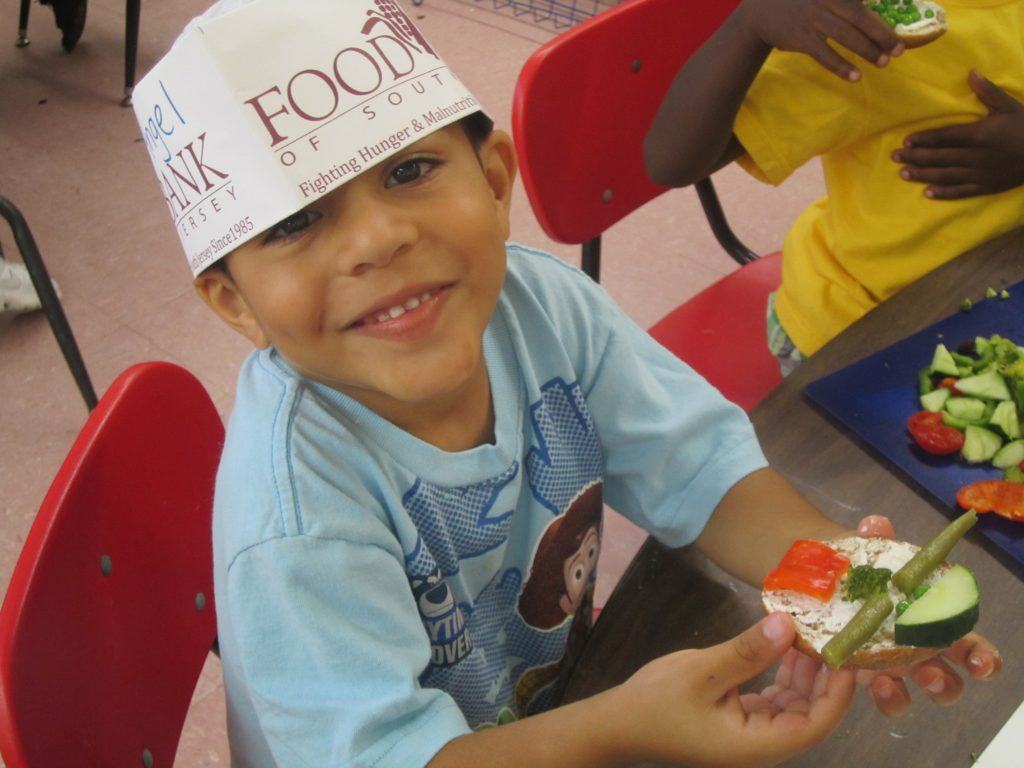Seven years ago, Val Traore was heading the Food Bank of South Jersey, distributing four million pounds of food to feed about 100,000 people. Despite those large numbers, she couldn’t help but think the nonprofit needed to do even more. The recession was in full swing, and the faces of the hungry were different – so were their needs. Traore set out to tackle problems that many would think couldn’t be helped. She didn’t agree.
What made you think the food bank needed to do more?
One day I was standing in line at the Dollar Store and I saw a young mother standing in front of me with cheese doodles in her cart. She said, ‘This is expensive but at least it’s healthy because it has cheese in it.” She had a 4- or 5-year-old, and she thought the cheese doodles were healthy, because she knew cheese is a dairy product and dairy products are healthy. That was my “AHA!” moment. I knew there were a lot of young mothers we needed to reach to start early lessons of good eating. I looked at that person as one person we didn’t reach, and there were probably 50,000 others that we hadn’t touched. We hadn’t done enough, soon enough. That was the impetus for me to go back to the team and tell them we had to do something to reach more.
So what did you do?
When I took over the leadership in 2006, we were pretty flat. We had one core thing that we did and that was to bring in food and distribute it to about 150 community partners. Now we have reinvented ourselves to be more than just a food distribution center, and to really incorporate a nutrition education piece into our work. We’ve worked to incorporate sustainable solutions to hunger and poverty in our work. As a result, we have nine additional direct-service programs that address the hunger needs of children, seniors and the working poor:
The Hope Mobile – A mobile food pantry that goes to remote areas where there are food desserts.
Twilight Harvest – Food boxes with a two-week supply of groceries are distributed to low-income seniors.
Kids Café – This is an after-school program where kids learn about eating healthy. They also receive a hot dinner.
Kids Pack – Every Friday, kids are given food to feed their family over the weekend.
Snack Zone – We go to places where kids are given snacks that aren’t necessarily healthy, and we replace them with healthy snacks.
Feed More – The Food Bank distributes 10 million pounds of food to emergency feeding programs like food pantries and soup kitchens.
SNAP Outreach – We help people understand what public benefits, like food stamps, they can receive.
School Pantry – We go to select schools and set up pantries, so entire families can come to the school and receive groceries.
Healthy Living Initiative – We teach cooking classes designed for children, tweens, teens, seniors and entire families.
When you set out to develop more programs, the recession was in full swing. Did you worry you wouldn’t have enough donations to maintain the new programs?
I have always worked in big cities – Chicago, New York, DC. The competition for dollars to support your work is competitive there. When I came to South Jersey, I expected the same thing because it’s a smaller community. I remember my first fundraising project in 2006. I was blown away by the response from the South Jersey people. Since that time in 2006 up to right now, South Jersey has not forsaken us. They have consistently supported us for the things we wanted to do for those in need. I’ve kind of been living off of that for the past seven years – if it’s something good for the people, South Jersey people will support us. They’ve been doing that for years. I should have been fearful, but I wasn’t.
 Some of your programs teach children as young as 4 how to prepare a meal. Why so young?
Some of your programs teach children as young as 4 how to prepare a meal. Why so young?
My mother died when I was 7, and then my father died shortly after. I was raised, along with my four siblings, by my maternal grandmother, who lost her husband about six months later. So really she was a single grandparent. While we did not go hungry, there was a scarcity of meals. My grandmother taught us a lot about what we call one-pot meals – low-cost meals that could stretch and fill your belly for a while. That type of cooking is just not done in our homes anymore, primarily because you have working parents. We’re trying to bring back “apron-side cooking.” We’re trying to show young children how to be able to take care of themselves. I’m personally connected, because I learned that so young, and it’s stayed with me throughout my life. I know the value of being able to cook one-pot meals that are affordable and healthy.
What is apron-side cooking?
Think about a mother or grandmother at the stove. They have an apron on cooking and a child next to them who stands about as high as their waist – we call that apron-side cooking. When the child’s height is as high as where the apron meets the mother’s waist, that’s about the time you should start teaching the child about cooking.
How many children do you help?
There are about 54,000 children in the four counties we provide for – Burlington, Camden, Gloucester and Salem Counties – who are living in food-insecure households. Last year, we reached about 4,000 of them.
What is the Peach Salsa Project?
That was a serendipitous idea. Some of our staff was traveling out to family farms, looking for farmers who would make donations of produce. We discovered there was a cooperative of small family farms in Gloucester County that were actually throwing away peaches, because they were too small or had one or two blemishes and weren’t suitable for their retail clients. It was costing them $85,000 to $100,000 a year for the disposal.
We took the peaches and put some of them in our nutrition programs as hand-held fruit for our seniors and our kids. With the rest, we wanted to see if we could repurpose them into a shelf-stable product. Campbell Soup Company has been a long-time partner of ours, and they developed a recipe for salsa for us. We put the product out in September and it’s now in 19 different locations, including ShopRite stores and farmer’s markets, and we’re about to put it into Wegmans.
It was a triple bottom-line item for us: we helped struggling farmers reduce their expense of dumping, we averted food from going into the landfill, and we developed a sustainable approach to some of our funding challenges. We’ve probably sold about 50 percent of our inventory and we recently hit the break-even mark, so anything from this point should be profit that will go back into our services and programs.
Will other products follow?
Possibly. We’ve had some interest from farmers who grow blueberries, cranberries and apples. We are thinking about that, but as a nonprofit, this is not our core competence. There’s a lot of learning we are doing here, and we want to bring in the right business partners to help us think that through. As an anti-hunger organization, the thought of any farmer throwing away food that can be used in our mission – we have a sense of urgency to respond to that. We just want to make sure we do it in a responsible way.
How are you able to collect all the food you need?
Keeping a constant flow of food coming into our facility is always a challenge. The food industry we’ve been so dependent on over the years has gotten smart and much more efficient with their surplus, so the pipeline of food from them dwindles every year. Then we have to rely heavily on government resources, but there are budget cuts every year. A big resource is the USDA Commodities Program, and that gets cut almost every year, so it’s a challenge for us to get a consistent supply of food from the government. Our third source is public food drives held by civic, religious and social organizations, some government entities and businesses. That’s where we fill in some of those gaps, but trying to provide for the food needs of 173,000 people every year is a daunting task.
Do you worry about continuing your work when many nonprofits are struggling?
We don’t ever see ourselves going out of business, because we look at ourselves as disaster relief. We look at hunger as a crisis situation. People lose their jobs and blaze through their savings, because they have to make ends meet. Sometimes they are making that difficult choice of whether they are going to pay for the electricity bill, the car note or the mortgage, and they suffer not having food. We want to be that place where people always know that as long as you live in the United States, and you live in South Jersey, you will never go hungry, because the Food Bank of South Jersey is here.
WEB BONUS
Who are you feeding?
Prior to 2008, most of the people who needed our services were the result of generational poverty, where you may find several generations within a family who have to use charitable feeding as a way to keep three square meals on the table.
After 2008, the face of hunger changed significantly. We started seeing people who were once earning decent money – upper-middle income people who were in mid-level and even senior-level positions who were affected by the economy. They wiped through their savings, burned out unemployment and found themselves coming to a food pantry, and in some cases, even a soup kitchen, to provide the adequate amount of food for themselves and their families. They started coming from communities that we never had before, like Collingswood, Haddonfield, Voorhees and Cherry Hill.
How successful are you in achieving your goals?
We are not successful at all, because every year the problem of hunger keeps increasing. Our services are more needed than they had been the previous year.
What do you teach to kids in your cooking classes?
We teach nutrition through cooking. We have a dietician and chef on staff. They conduct four-, six- and eight-week courses designed for children, tweens, teens, seniors and entire families. We teach the basics of cooking. We teach small children how to handle a cooking knife. We teach the older kids how to cut and dice. We teach how to prepare healthy, low-fat, low-sugar and low-salt foods. We teach how to sauté instead of frying. We teach the value of a variety of vegetables and how to cook them. At the end of every class, they get the ingredients of that class’ meal so they can replicate that at home.
Many of the children in the communities we provide for are preparing meals for themselves because mom or dad or whoever their guardian is are at work, so the children are left at home by themselves and they have to feed themselves. We want to teach them skills early on, with the intent that you learn healthy eating so those best practices will stay with you your entire life.



 Some of your programs teach children as young as 4 how to prepare a meal. Why so young?
Some of your programs teach children as young as 4 how to prepare a meal. Why so young?










